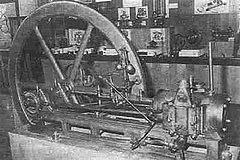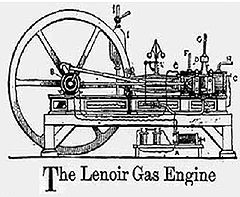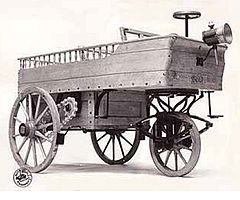
Etienne Lenoir
Encyclopedia
Jean Joseph Étienne Lenoir (12 January 1822 - 4 August 1900) was a Belgian
engineer who developed the internal combustion engine
in 1859. Prior designs for such engines were patented as early as 1807, but none were commercially successful. Lenoir's engine was commercialized in sufficient quantities to be considered a success, a first for the internal combustion engine.
He was born in Mussy-la-Ville (then in Luxembourg
, part of Belgium
from 1839). By the early 1850s he had emigrated to France, taking up residence in Paris
, where he developed an interest in electroplating
. His interest in the subject led him to make electrical inventions including an improved electric telegraph.

 By 1859, Lenoir's experimentation without electricity led him to develop the first single-cylinder two-stroke engine which burnt a mixture of coal gas
By 1859, Lenoir's experimentation without electricity led him to develop the first single-cylinder two-stroke engine which burnt a mixture of coal gas
and air ignited by a "jumping spark" ignition system
by Ruhmkorff coil
, and which he patented in 1860. The engine differed from more modern two-stroke engines in that the charge was not compressed before ignition (a system invented in 1801 by Lebon D'Humberstein, which was quiet but inefficient), with a power stroke at each end of the cylinder. In 1863 the Hippomobile
with a hydrogen gas fuelled one cylinder internal combustion engine made a test drive from Paris
to Joinville-le-Pont
: top speed about 9 km in ~3 hours.
Lenoir was an engineer at petiene et Cie, who formed companies (Société des Moteurs Lenoir+ more) in Paris in 1859, with a capitalization of two million franc
s and a factory in the Rue de la Roquette, to develop the engine, and a three-wheeled carriage constructed using it. Although it ran reasonably well, the engine was fuel inefficient, extremely noisy, tended to overheat and, if sufficient cooling water was not applied, seize up. Nevertheless, Scientific American
advised in September 1860 the Parisian newspaper Cosmos had pronounced the steam age over, and by 1865, 143 had been sold in Paris alone, and production by Reading Gas Works for Lenoir Gas Engines in London had begun.
 In 1863 Lenoir demonstrated a second three-wheeled carriage, little more than a wagon body set atop a tricycle platform. It was powered by a 2543 cc (155 in3; 180×100 mm, 7.1×3.9in) 1.5 hp "liquid hydrocarbon" (petroleum
In 1863 Lenoir demonstrated a second three-wheeled carriage, little more than a wagon body set atop a tricycle platform. It was powered by a 2543 cc (155 in3; 180×100 mm, 7.1×3.9in) 1.5 hp "liquid hydrocarbon" (petroleum
) engine with a primitive carburettor which was patented in 1886. It successfully covered the 11 km (7 mi) from Paris to Joinville-le-Pont
and back in about ninety minutes each way, an average speed less than that of a walking man (though doubtless there were breakdowns). This succeeded in attracting the attention of tsar
Alexander II
, and one was sent to Russia, where it vanished. (Lenoir himself was not pleased, however; in 1863, he sold his patents to Compagnie Parisienne du Gaz and turned to motorboat
s, instead, building a naptha-fuelled four-cycle in 1888.)
Most applications of the Lenoir engine were as a stationary power plant powering printing presses, water pumps, and machine tools. They "proved to be rough and noisy after prolonged use", however. Other engineers, especially Nikolaus Otto, began making improvements in internal combustion technology which soon rendered the Lenoir design obsolete. Less than 500 Lenoir engines of between 6 and 20 hp were built, including some under licence in Germany.
, and awarded the Légion d'honneur
in 1881 (not for the engine, but for developments in telegraphy), Lenoir's later years were impoverished despite his engine's success.
Lenoir died in at La Varenne-Sainte-Hilaire on August 4, 1900.
Belgium
Belgium , officially the Kingdom of Belgium, is a federal state in Western Europe. It is a founding member of the European Union and hosts the EU's headquarters, and those of several other major international organisations such as NATO.Belgium is also a member of, or affiliated to, many...
engineer who developed the internal combustion engine
Internal combustion engine
The internal combustion engine is an engine in which the combustion of a fuel occurs with an oxidizer in a combustion chamber. In an internal combustion engine, the expansion of the high-temperature and high -pressure gases produced by combustion apply direct force to some component of the engine...
in 1859. Prior designs for such engines were patented as early as 1807, but none were commercially successful. Lenoir's engine was commercialized in sufficient quantities to be considered a success, a first for the internal combustion engine.
He was born in Mussy-la-Ville (then in Luxembourg
Luxembourg
Luxembourg , officially the Grand Duchy of Luxembourg , is a landlocked country in western Europe, bordered by Belgium, France, and Germany. It has two principal regions: the Oesling in the North as part of the Ardennes massif, and the Gutland in the south...
, part of Belgium
Belgium
Belgium , officially the Kingdom of Belgium, is a federal state in Western Europe. It is a founding member of the European Union and hosts the EU's headquarters, and those of several other major international organisations such as NATO.Belgium is also a member of, or affiliated to, many...
from 1839). By the early 1850s he had emigrated to France, taking up residence in Paris
Paris
Paris is the capital and largest city in France, situated on the river Seine, in northern France, at the heart of the Île-de-France region...
, where he developed an interest in electroplating
Electroplating
Electroplating is a plating process in which metal ions in a solution are moved by an electric field to coat an electrode. The process uses electrical current to reduce cations of a desired material from a solution and coat a conductive object with a thin layer of the material, such as a metal...
. His interest in the subject led him to make electrical inventions including an improved electric telegraph.
Lenoir engine


Coal gas
Coal gas is a flammable gaseous fuel made by the destructive distillation of coal containing a variety of calorific gases including hydrogen, carbon monoxide, methane and volatile hydrocarbons together with small quantities of non-calorific gases such as carbon dioxide and nitrogen...
and air ignited by a "jumping spark" ignition system
Ignition system
An ignition system is a system for igniting a fuel-air mixture. Ignition systems are well known in the field of internal combustion engines such as those used in petrol engines used to power the majority of motor vehicles, but they are also used in many other applications such as in oil-fired and...
by Ruhmkorff coil
Induction coil
An induction coil or "spark coil" is a type of disruptive discharge coil. It is a type of electrical transformer used to produce high-voltage pulses from a low-voltage direct current supply...
, and which he patented in 1860. The engine differed from more modern two-stroke engines in that the charge was not compressed before ignition (a system invented in 1801 by Lebon D'Humberstein, which was quiet but inefficient), with a power stroke at each end of the cylinder. In 1863 the Hippomobile
Hippomobile (car)
The Hippomobile is an automobile invented by Étienne Lenoir in 1863 which carried its own internal combustion engine. It was based on his 1860 invention the Lenoir gas engine...
with a hydrogen gas fuelled one cylinder internal combustion engine made a test drive from Paris
Paris
Paris is the capital and largest city in France, situated on the river Seine, in northern France, at the heart of the Île-de-France region...
to Joinville-le-Pont
Joinville-le-Pont
Joinville-le-Pont is a commune in the southeastern suburbs of Paris, France. It is located from the center of Paris.-History:The commune was created in 1791 under the name La Branche-du-Pont-de-Saint-Maur by detaching its territory from the commune of Saint-Maur-des-Fossés...
: top speed about 9 km in ~3 hours.
Lenoir was an engineer at petiene et Cie, who formed companies (Société des Moteurs Lenoir+ more) in Paris in 1859, with a capitalization of two million franc
French franc
The franc was a currency of France. Along with the Spanish peseta, it was also a de facto currency used in Andorra . Between 1360 and 1641, it was the name of coins worth 1 livre tournois and it remained in common parlance as a term for this amount of money...
s and a factory in the Rue de la Roquette, to develop the engine, and a three-wheeled carriage constructed using it. Although it ran reasonably well, the engine was fuel inefficient, extremely noisy, tended to overheat and, if sufficient cooling water was not applied, seize up. Nevertheless, Scientific American
Scientific American
Scientific American is a popular science magazine. It is notable for its long history of presenting science monthly to an educated but not necessarily scientific public, through its careful attention to the clarity of its text as well as the quality of its specially commissioned color graphics...
advised in September 1860 the Parisian newspaper Cosmos had pronounced the steam age over, and by 1865, 143 had been sold in Paris alone, and production by Reading Gas Works for Lenoir Gas Engines in London had begun.

Petroleum
Petroleum or crude oil is a naturally occurring, flammable liquid consisting of a complex mixture of hydrocarbons of various molecular weights and other liquid organic compounds, that are found in geologic formations beneath the Earth's surface. Petroleum is recovered mostly through oil drilling...
) engine with a primitive carburettor which was patented in 1886. It successfully covered the 11 km (7 mi) from Paris to Joinville-le-Pont
Joinville-le-Pont
Joinville-le-Pont is a commune in the southeastern suburbs of Paris, France. It is located from the center of Paris.-History:The commune was created in 1791 under the name La Branche-du-Pont-de-Saint-Maur by detaching its territory from the commune of Saint-Maur-des-Fossés...
and back in about ninety minutes each way, an average speed less than that of a walking man (though doubtless there were breakdowns). This succeeded in attracting the attention of tsar
Tsar
Tsar is a title used to designate certain European Slavic monarchs or supreme rulers. As a system of government in the Tsardom of Russia and Russian Empire, it is known as Tsarist autocracy, or Tsarism...
Alexander II
Alexander II of Russia
Alexander II , also known as Alexander the Liberator was the Emperor of the Russian Empire from 3 March 1855 until his assassination in 1881...
, and one was sent to Russia, where it vanished. (Lenoir himself was not pleased, however; in 1863, he sold his patents to Compagnie Parisienne du Gaz and turned to motorboat
Motorboat
A motorboat is a boat which is powered by an engine. Some motorboats are fitted with inboard engines, others have an outboard motor installed on the rear, containing the internal combustion engine, the gearbox and the propeller in one portable unit.An inboard/outboard contains a hybrid of a...
s, instead, building a naptha-fuelled four-cycle in 1888.)
Most applications of the Lenoir engine were as a stationary power plant powering printing presses, water pumps, and machine tools. They "proved to be rough and noisy after prolonged use", however. Other engineers, especially Nikolaus Otto, began making improvements in internal combustion technology which soon rendered the Lenoir design obsolete. Less than 500 Lenoir engines of between 6 and 20 hp were built, including some under licence in Germany.
Later years
Granted French citizenship 1870 for assistance during the Franco-Prussian WarFranco-Prussian War
The Franco-Prussian War or Franco-German War, often referred to in France as the 1870 War was a conflict between the Second French Empire and the Kingdom of Prussia. Prussia was aided by the North German Confederation, of which it was a member, and the South German states of Baden, Württemberg and...
, and awarded the Légion d'honneur
Légion d'honneur
The Legion of Honour, or in full the National Order of the Legion of Honour is a French order established by Napoleon Bonaparte, First Consul of the Consulat which succeeded to the First Republic, on 19 May 1802...
in 1881 (not for the engine, but for developments in telegraphy), Lenoir's later years were impoverished despite his engine's success.
Lenoir died in at La Varenne-Sainte-Hilaire on August 4, 1900.
See also
- Lenoir cycleLenoir cycleThe Lenoir cycle is an idealized thermodynamic cycle often used to model a pulse jet engine. It is based on the operation of an engine patented by Jean Joseph Etienne Lenoir in 1860. This engine is often thought of as the first commercially produced internal combustion engine...
- History of the internal combustion engineHistory of the internal combustion engineAlthough various forms of internal combustion engines were developed before the 19th century, their use was hindered until the commercial drilling and production of petroleum began in the mid-1850s...
- Timeline of hydrogen technologiesTimeline of hydrogen technologiesTimeline of hydrogen technologies — A timeline of the history of hydrogen technology.-1600s:* 1625 - First description of hydrogen by Johann Baptista van Helmont...
Sources
- Georgano, G.N. Cars: Early and Vintage 1886-1930. London: Grange-Universal, 1990 (reprints AB Nordbok 1985 edition). ISBN 0-9509620-3-1.
- Wise, David Burgess, "Lenoir: The Motoring Pioneer" in Ward, Ian, executive editor. The World of Automobiles, p. 1181-2. London: Orbis Publishing, 1974.

